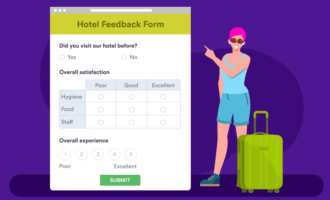Strategies to avoid survey fatigue
- Create a survey schedule
- Segment your customer base
- Use an effective survey design tool
- Try A/B testing for survey questions
- Customize the content
Many organizations use surveys to gather helpful insights from customers. But if you’re experiencing a high rate of incomplete surveys, your customers might be suffering from something called survey fatigue. Survey fatigue is a common problem for organizations, but you can — and should — take steps to address it.
In this article, we cover the different reasons customers feel survey fatigue and offer preventative strategies that will help you avoid it.
Types of survey fatigue
While many customers enjoy providing feedback on their experiences, survey fatigue can cause some respondents to become uninterested in filling out questionnaires. According to Olivia Tsang, growth marketing director at the mortgage lending platform Fraction, survey fatigue leads to both lower survey response rates and less accurate responses.
Survey fatigue can happen at two different points in the survey process:
- Before starting the survey: In this situation, the customer is getting too many requests to fill out surveys and is feeling overwhelmed. It doesn’t matter whether the requests are from one organization or multiple organizations at once — what matters is that there are too many requests on the table. Before even opening up the survey, the customer decides they don’t want to offer any feedback.
- During the survey process: In this situation, the customer has opened the survey and started going through it. However, at some point, they feel discouraged from completing it. This could be due to a number of reasons related to the content and design of the survey itself, such as its question types, length, visual elements, ease of use, and more.
In both cases, the customer doesn’t provide the organization with a fully completed survey. As a result, the organization doesn’t receive the valuable insights they were hoping to get from their target audience.
Reasons for survey fatigue
Survey fatigue happens for a number of reasons, so it’s important to understand what could be preventing your customers from answering your questions. Once you know what’s causing the problem, you’re in a much better position to fix the issue.
Here are some common reasons for survey fatigue.
- The survey is targeting the wrong audience. Imagine if you receive a survey from a store you’ve never shopped at asking how you felt about its customer service. You likely wouldn’t fill it out because the topic isn’t relevant to you. If a customer doesn’t feel the survey is directed at them, the exercise will feel like a waste of time.
- The customer has received too many survey requests. If a customer has received multiple survey requests from your organization or others, they may become indifferent or even annoyed. Too-frequent requests can jeopardize your chances of getting a response.
- The customer doesn’t have the time or energy to answer all the survey questions. Getting the length of your survey right is key. A survey should be long enough for you to gather the data you need and short enough to keep the customer interested and engaged the whole way through.
- The survey is poorly designed and difficult to use. If a survey has technical glitches, isn’t intuitive, is hard to read, or looks unappealing, a customer likely won’t complete it. Without a smooth experience, a customer won’t want to spend their time answering survey questions.
- The survey questions are complicated, difficult to understand, or uninteresting. Questions must be easy to understand and engaging enough to elicit a response.
Strategies to avoid survey fatigue
Whether you’re dealing with survey fatigue right now or want to mitigate it in the future, there are a number of steps you can take to ensure people fill out and submit your surveys.
Create a survey schedule
A simple way to avoid over-surveying customers is to plan out your survey schedule over the course of several months or a year. This way, you can strategically decide what information you need to gather and when you need to gather it.
How often should you survey customers? It depends on your industry and the type of customer. For example, business-to-business organizations should survey their clients no more than once a quarter.
The rule for business-to-customer organizations varies depending on how often they interact with customers. For example, if an organization interacts with a customer on a weekly basis, they can likely send out surveys more frequently than if they interact with customers once a year.
Segment your customer base
Instead of sending every survey to all your customers, try targeting specific surveys to specific customers to improve your survey response rate. For example, a survey on customer service is more relevant to recent customers — say, those who’ve made a purchase within the past three months — than those who haven’t purchased anything in over a year.
Use an effective survey design tool
The medium of your survey matters just as much as the message. If the survey is difficult to use or complete, the customer might not finish it, even if they want to provide feedback to the business. So the survey tool you use should allow you to customize the survey’s look and feel, add a progress bar, use branching logic, and more — all of which will help make your survey visually appealing and easy to complete.
“Make your surveys engaging and fun,” says Tsang. “Visuals and thought-provoking questions can help people engage.”
Try A/B testing for survey questions and length
It can be difficult to know right off the bat whether a survey will be appealing to customers, so many organizations opt to test their surveys on a small sample size to see what they can change to improve completion rates. For example, you might test whether a survey with five questions will fare better than a survey with 10 questions or whether phrasing questions in a certain way will elicit a higher response rate.
“Your surveys should be short and to the point,” says Tsang. “People do not like to spend a lot of time answering questions. Don’t make your visitors fill out essays!”
Customize the content
Ensure the content of the survey is consistently relevant to participants. Use branching logic so they only see questions that are relevant to them, based on information they’ve already provided. This makes the survey experience feel more personal and engaging, which will provide more motivation to complete the survey.
If the survey doesn’t use branching logic, it may present irrelevant questions or answer options, causing respondents to abandon the effort partway through the process.
Jotform: The ideal solution for avoiding survey fatigue
Boost your response rate with Jotform, a survey maker that helps organizations get the answers they need from their customers.
With hundreds of easily customizable survey templates, an intuitive drag-and-drop user interface, and helpful features like branching logic, progress bars, and embed options, Jotform gives you the ability to create and distribute engaging surveys that customers will actually fill out. Not only that, Jotform offers reporting tools that help you turn raw survey data into helpful insights. Plus, every survey you create with Jotform is highly secure and can be encrypted.






































































































Send Comment: